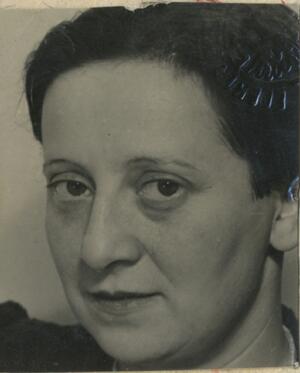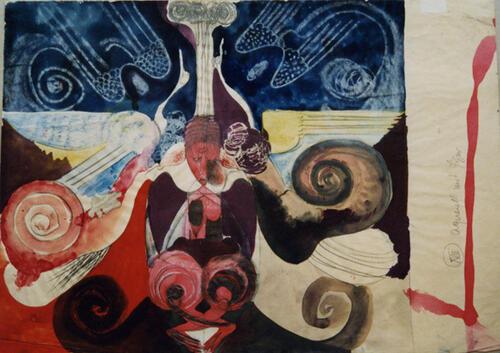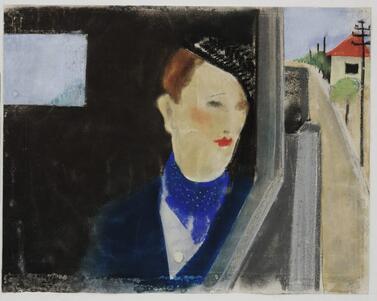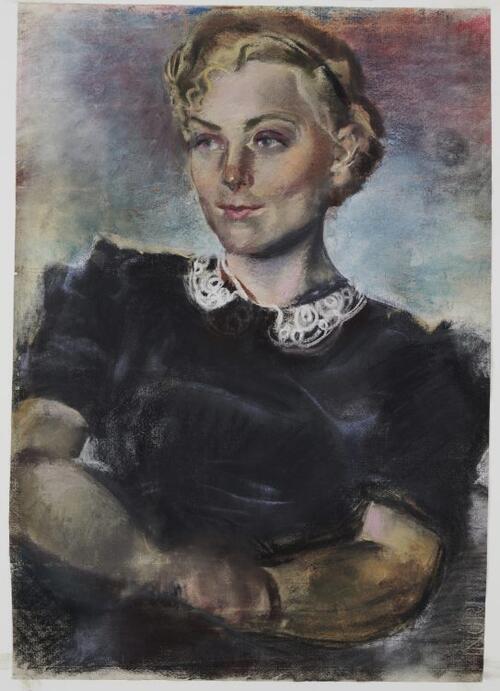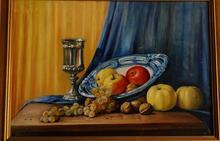Friedl Dicker-Brandeis
Friedl Dicker was an artist and educator who studied at the Bauhaus school then led art classes at Terezin. After her time at the Bauhaus school, Dicker worked as an artist and teacher in Vienna and Prague before being sent to Terezin in 1942. In the ghetto, Dicker taught drawing to hundreds of children. She also designed sets and costumes for at least two children’s performances and made an exhibition of children’s drawings in a basement. In the summer of 1944, when the transports to death camps were temporarily suspended, Dicker dedicated herself to painting. Many works were never completed and remained as sketches. Over 130 of her sketches were discovered in the 1980s and are now at the Simon Wiesenthal Center, Los Angeles.
Aesthetics as just another, thinner skin protecting against chaos … Aesthetics, last instance, means of escape, last motor capable of creating production, while defending man from forces over which he has no control …
Friedl Dicker-Brandeis to Hilde Kothny, Hronov, December 9, 1940.
More than half a century after the death of Friedl Dicker-Brandeis, researchers from many countries and from diverse disciplines began to express a new interest in her, focusing respectively on her paintings, furniture and stage designs, and her teaching in Theresienstadt (Terezin), a ghetto established by the Germans in Czechoslovakia
Early Life and Family
Friedl (Frederika) Dicker was born in Vienna on July 30, 1898, into a poor Jewish family. Her father was a shop-assistant; her mother, Karolina, died in 1902. Lack of a mother and of motherhood became a central trauma of Friedl’s life; she eventually compensated for it by becoming a mother for hundreds of young students in the Terezin ghetto.
In 1915, after a course of photography and early experiences in a street puppet theater, Friedl joined the textile department of the School of Art and Crafts. There she began to attend the drawing class given by Professor Franz Cizek (1865–1946), who encouraged free creativity, focusing on the students’ inner world and telling them: “Today show me your soul!” Her next instructor, Johannes Itten (1888–1967), was a stern mystic. In his private school, which she joined in 1916, the students were supposed to “live through the line while following their feelings.” The means of art was the transference of the inner movement of the soul, but the end of art was spiritual progress.
At Itten’s school, Friedl met Franz Singer and Anny Wottitz, who both became long-time friends and collaborators. In the same period, Friedl became captivated by music and even took a harmony course at Arnold Schoenberg’s school. It was probably there that she met and befriended two other distinguished composers, Viktor Ullmann (1898–1942 Terezin, 1944 Auschwitz) and Stefan Wolpe (1902–1972), who both dedicated pieces to her.
Bauhaus School
In 1919, Friedl followed Itten to the Weimar Bauhaus, where she studied until 1923. The Bauhaus teaching program was perfect for her, as it promoted both her inner development and her practical relationship to art. She fought her way to the printing presses and the metalworking machines and quickly mastered weaving. The director of the Bauhaus, Walter Gropius (1883–1969), later commended “the multifaceted nature of her gifts and her unbelievable energy” and stated that “already in her first year she began to teach the beginners” (letter of 19.04.31).
The Bauhaus school’s agenda comprised more than progressive art. In the economic and moral crises following World War I and the Russian Revolution, it dealt with issues of social justice and the question of how to build a better world. This climate probably nurtured Friedl’s later dedication to a utopian form of Communism, and she designed special “expressive” typefaces for Itten’s almanac “Utopia.”
In 1923 Friedl Dicker and Franz Singer established the “Workshops of Fine Art” in Berlin. The sample folder and the works preserved from this period show a variety of products such as bookcovers, textile works and children’s toys. They also worked as stage and costume designers, chiefly for Berthold Viertel’s theater “Die Truppe.”
Vienna and Crafting
In 1925 Friedl returned to Vienna and continued working in the crafts together with Martha Döberl and Anny Wottitz. Singer, with whom Friedl had a long and painful love relationship, soon came to Vienna, and in 1926 the Atelier Singer-Dicker was established. The architectonic works, innovative furniture and other objects of interior design produced at the studio received awards at several exhibitions. In 1930, when the Atelier was commissioned to provide furnishings for an innovative “model kindergarten of proletarian Red Vienna,” they designed toys to stimulate the children’s intellectual abilities, as well as folding beds, tables and chairs, so that the children could transform a canteen into a dormitory, and the latter into a playroom. The Atelier also executed architectural designs for the Vienna Tennis Club (1928) and a guesthouse for Countess Heriot (1934).
Friedl’s educational career seems to have started in 1931 when the city of Vienna invited her to give an art course for kindergarten teachers. However, in 1934, during the rightist putsch in Vienna, she was arrested for Communist activities. After a short imprisonment, she moved to Prague, which was at that time a stronghold of democracy in Nazi-infested Central Europe.
Career and Life in Prague
This move changed the course of Friedl’s life. She married her cousin, the accountant Pavel Brandeis, and received Czech citizenship. She also began to develop her gifts as a painter, passing from constructivism to figurative art. From 1934 to 1938, while working with children of political emigrés from Germany, she began to apply the system she had learned from Itten, forming an intense bond with the children. According to the reminiscences of her students and friends, her mere presence and maternal warmth were enough to create a positive atmosphere.
Friedl Dicker-Brandeis was also politically active in Prague. In her underground party cell, she met a German, Hilde Kothny, who remained her bosom friend until Friedl’s deportation to Terezin. In 1938 Friedl obtained a visa for Palestine, but refused to leave. Instead, she and her husband moved to Hronov, a provincial town northeast of Prague. Here she worked as a textile designer for B.Spiegler & Söhne and soon received an award at the exhibit Vystava 38 Nachod (June–August, 1938).
The anti-Jewish laws forced the couple to drastically reduce their standard of living. However, it was in Hronov, under German occupation, that Friedl’s painting began to flourish. Clearly, no exhibitions were possible, the only exception being a small presentation arranged by her friends in London in 1940. In her detailed and passionate letters to Hilde, Friedl reflected on art, religion, history, philosophy and ideology, even giving her friend a correspondence course on art history.
Teaching at Terezin
In late Autumn 1942, the Brandeises received a deportation order and on December 17, 1942 they were sent to Terezin. In the ghetto, Friedl taught drawing to hundreds of children. She also designed sets and costumes for at least two children’s performances and made an exhibition of children’s drawings in the basement of their house. As an art-teacher in Terezin Friedl saw her goal as restoring the shaken inner world of the children. She used a modified Bauhaus system to develop emotional concentration in order to compensate for the chaos of time and space. In her work with children, all her resources merged: her charismatic personality, huge energy, innovative teaching methods, refined artistic skills and deep insight into children’s psychology.
In the summer of 1943, at a teachers’ seminar in the camp, she lectured on “Children’s Drawing,” stressing the meaning and the purpose of their art, which she saw as the “greatest possible freedom for the child.” She discussed the distinctive characteristics of children with regard to age and psychological development, and offered her views on how adults should act toward children and their art: “Why do adults want to make children be like themselves as quickly as possible?… Childhood is not a preliminary, immature stage on the way to adulthood. By prescribing the path to children, we are leading them away from their own creative abilities and we lead ourselves away from understanding the nature of these abilities.” On the basis of her experiences in working with children, she also hoped to write her own study on art as therapy for children.
The children were greatly influenced by her. Survivors say that she was “the mystery of beauty,” “the mystery of freedom.” Her former student, Erna Furman, wrote: “Friedl’s teaching, the times spent drawing with her, are among the fondest memories of my life. Terezin made it more poignant but it would have been the same anywhere in the world... Friedl was the only one who taught without ever asking for anything in return. She just gave of herself.” (A letter to Elena Makarova, 1989)
On October 6, 1944, Friedl was deported to Auschwitz together with some of her students (transport EO-167) and gassed. After her death, over five thousand drawings made in her classes were found; most of them are now in the Jewish Museum, Prague.
Artwork and Legacy
Her own artworks are more rarely seen. Through hot temper and lack of self-confidence, she destroyed a number of works. Quite often she did not sign her creations, including her last sixty works from Terezin. In Hronov, as she moved into ever smaller apartments, and before her deportation, she gave many of her paintings and drawings to friends, students and relatives of her husband, or left them with neighbors.
Like her personal life, Friedl’s artistic life is divided into three main periods: from the Bauhaus to Prague (1919–1934), from Prague to Terezin (1934–1942), and Terezin (1942–1944). The works from the first period show the clear influence of Itten’s teaching. The sketches and finished drawings of this period were done in many techniques, in a quick and spontaneous style, while the sculptures are constructivist and architectonic. These works, which at first seem so open, conceal secrets: something is happening behind the scenes, “behind the mirror” of the image, at which one can only guess.
Her second creative period is characterized by a decisive shift toward painting. In her transitional work, The Interrogation, she mixes graphic elements such as typewriter letters on wood with oil painting. The Interrogation is her only self-portrait, but even here she turns her back on the observer, seeming to be keeping her distance even from herself. During this period, she also painted landscapes, still-lifes, portraits, and figurative allegories—such as The Interrogation, Fuchs Learns Spanish, Don Quixote and Lenin—to symbolize rather than to chronicle events. In contrast, her anti-capitalist and anti-fascist posters are immediately accessible, utilizing photomontage.
Most of the time at Terezin, she was engaged in teaching children. Only in the summer of 1944, when the transports to death camps were temporarily suspended, did she dedicate herself completely to painting. “I am painting with all possible intensity,” she wrote to her sister-in-law Maria Brandeis in August 1944, two months before her death. Her works from Terezin are formally different from her earlier works because paper and paints were in short supply. Many works were never completed and remained as sketches, and many are simply variations on the same composition. The themes continue to be landscapes, flowers, people, street scenes, nudes, abstract compositions, and sketches for theater productions. The ghetto’s environment is ignored: there are no transports, no crowds, no soup lines, no dead bodies, no darkness.
These last works, over one hundred and thirty of which are now at the Simon Wiesenthal Center, Los Angeles, were discovered only in the 1980s, as were one hundred of her letters from 1938–42 to Hilde Kothny, and a number to Anny Wottitz-Moller. Thus only at the end of the twentieth century, due to discovery of hundreds of unknown artworks, letters and memoirs, and owing to publications and exhibits in different countries, did Friedl Dicker-Brandeis begin to take her deserved place as artist, teacher and outstanding personality.
Exhibitions
London (1940, together with Gerald Davis).
Darmstadt (1970).
Prague (1988).
Moscow (1988).
Vienna (1989).
Basel (1989).
Jerusalem (1990).
Frankfurt (1991).
Vienna (1999).
Graz (2000).
Czesky Krumlov (2000).
Paris (2000-2001).
Stockholm (2001).
Berlin (Bauhaus Archive/Museum, 2001).
Atlanta (2001-2002).
Tokyo (and five more venues in Japan, 2002).
Los Angeles (2003).
Milan (2003).
New York (2005).
Adler, Bruno, ed. Utopia. Dokumente der Wirklichkeit. Weimar: 1921.
Bauhaus Experiment. Exhibition Catalog, Darmstadt:1989.
Bauhaus in Wien. Franz Singer, Friedl Dicker. Exhibition Catalogue, Vienna: 1989.
Hildebrandt, Hans. Die Frau als Künstlerin. Berlin: 1928.
Hurwitz, Al. “Friedl Dicker: The Art Educator As Hero.” Journal of Art & Design Education, v. 7, no 3, (1988): 249–259.
Itten, Johannes. Design and Form: The Basic Course at the Bauhaus. London: 1964.
Makarova, Elena. From Bauhaus to Terezin. Friedl Dicker-Brandeis and Her Pupils. Exhibition Catalog, Jerusalem: 1990.
Makarova, E. “Friedl Remembered.” Jewish Art, v. 16/17 (1990/1991): 122–130.
Makarova, E. “A Few Truths of Friedl.” Ariel, no 4, (1991): 39–53.
Makarova, E. Therezienstadt Cultur Och Barbari. Stockholm: 1995.
Makarova, E. Friedl Dicker-Brandeis. Ein Leben Für Kunst Und Lehre. Vienna: 1999.
Makarova, E. “Friedl.” Jahrhundert der Frauen. Von Impressionismus zur Gegenwart, Oesterreich 1870 bis heute, Exhibition Catalogue, Vienna (1999): 158–166.
Makarova, E. Friedl Dicker-Brandeisova. Život pro umeni a ponaučeni. Český Krumlov: 2000.
Makarova, E. Friedl Dicker-Brandeis. Vienne 1898 —Auschwitz 1944. Paris: 2000.
Makarova, E., Makarov, S., Kuperman, V. University Over The Abyss. Lectures And Lecturers In Terezin. Jerusalem: 2000.
Makarova, E. Long Live Life! Theater In Terezin 1941–1945. Jerusalem: 2001.
Makarova, E. “Dicker-Brandeis, Friedl.” In Allgemeines Kuenstlerlexikon, 68–69. Munich: 2001.
Makarova, E. Friedl Dicker-Brandeis. Vienna 1898–Auschwitz 1944: Light Defining Darkness. Los Angeles: 2001.
Parik, Arno, “Friedl Dicker-Brandeis.” Etudes (1988): 69–81.
Wingler, Hans M. Friedl Dicker, Franz Singer. Exhibition Catalogue, Darmstadt: 1970.

